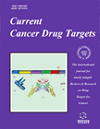-
s Sildenafil Inhibits the Growth and Epithelial-to-mesenchymal Transition of Cervical Cancer via the TGF-β1/Smad2/3 Pathway
- Source: Current Cancer Drug Targets, Volume 23, Issue 2, Feb 2023, p. 145 - 158
-
- 01 Feb 2023
Abstract
Aims: The study aims to explore new potential treatments for cervical cancer. Background: Cervical cancer is the second most common cancer in women, causing >250,000 deaths worldwide. Patients with cervical cancer are mainly treated with platinum compounds, which often cause severe toxic reactions. Furthermore, the long-term use of platinum compounds can reduce the sensitivity of cancer cells to chemotherapy and increase the drug resistance of cervical cancer. Therefore, exploring new treatment options is meaningful for cervical cancer. Objective: The present study was to investigate the effect of sildenafil on the growth and epithelial-tomesenchymal transition (EMT) of cervical cancer. Methods: HeLa and SiHa cells were treated with sildenafil for different durations. Cell viability, clonogenicity, wound healing, and Transwell assays were performed. The levels of transforming growth factor-β1 (TGF-β1), transforming growth factor-β type I receptor (TβRI), phosphorylated (p-) Smad2 and p-Smad3 in cervical cancer samples were measured. TGF-β1, Smad2 or Smad3 were overexpressed in HeLa cells, and we measured the expression of EMT marker proteins and the changes in cell viability, colony formation, etc. Finally, HeLa cells were used to establish a nude mouse xenograft model with sildenafil treatment. The survival rate of mice and the tumor size were recorded. Results: High concentrations of sildenafil (1.0-2.0 μM) reduced cell viability, the number of HeLa and SiHa colonies, and the invasion/migration ability of HeLa and SiHa cells in a dose- and time-dependent manner. The expression of TGF-β1, TβRI, p-Smad2 and p-Smad3 was significantly enhanced in cervical cancer samples and cervical cancer cell lines. Sildenafil inhibited the expression of TGF-β1-induced EMT marker proteins (Snail, vimentin, Twist, E-cadherin and N-cadherin) and p-Smad2/3 in HeLa cells. Overexpression of TGF-β1, Smad2, and Smad3 reversed the effect of sildenafil on EMT, viability, colony formation, migration, and invasion ability of HeLa cells. In the in vivo study, sildenafil significantly increased mouse survival rates and suppressed xenograft growth. Conclusion: Sildenafil inhibits the proliferation, invasion ability, and EMT of human cervical cancer cells by regulating the TGF-β1/Smad2/3 pathway.


